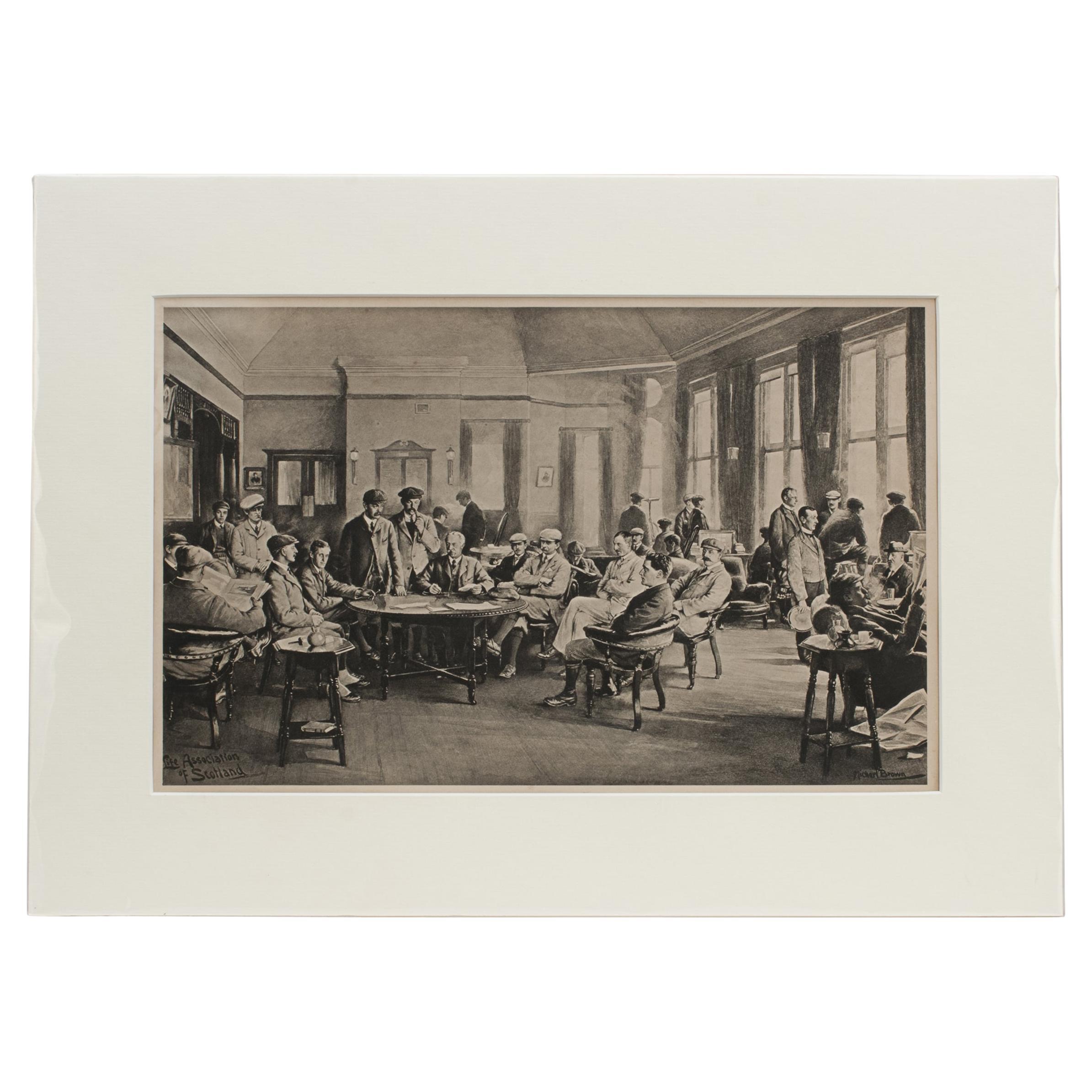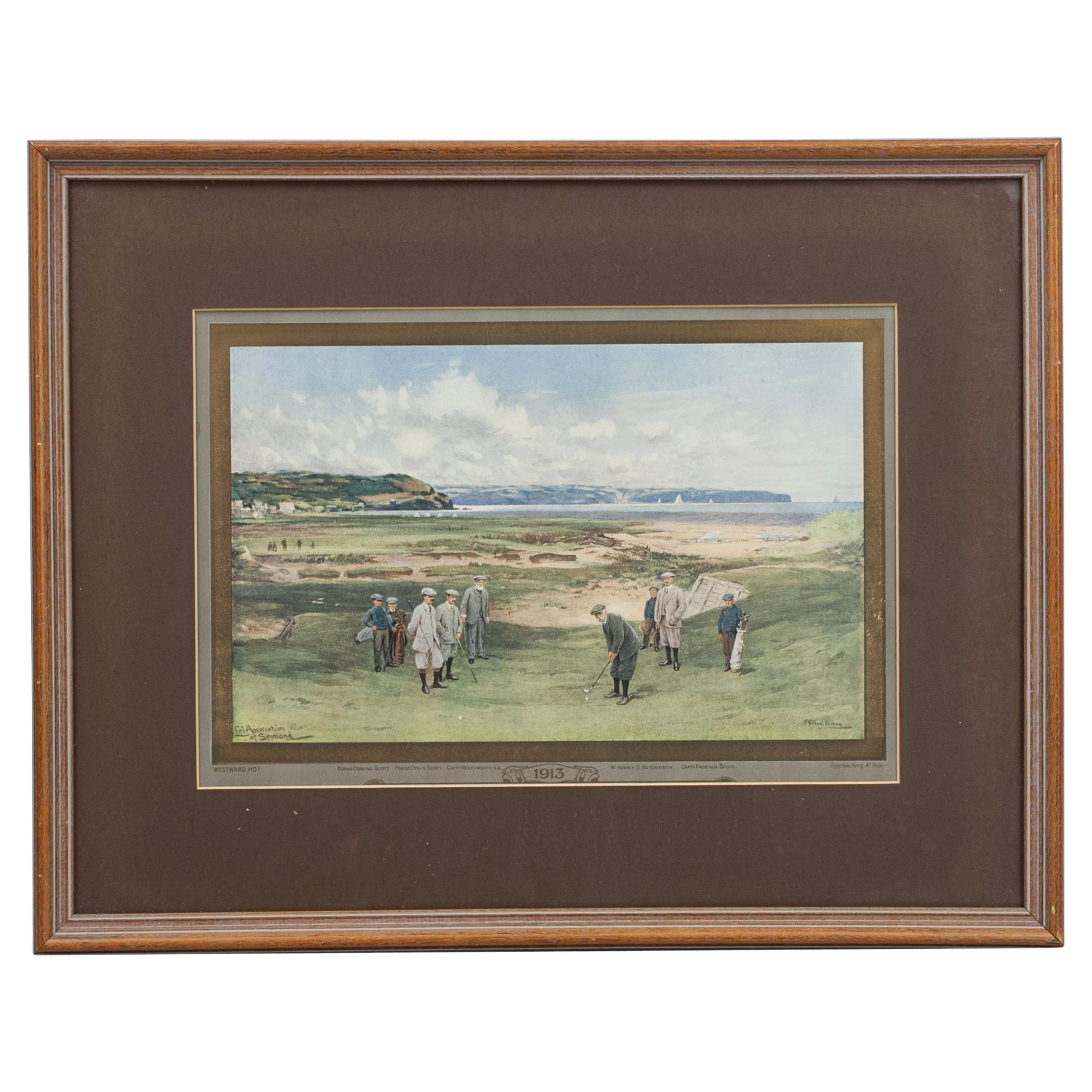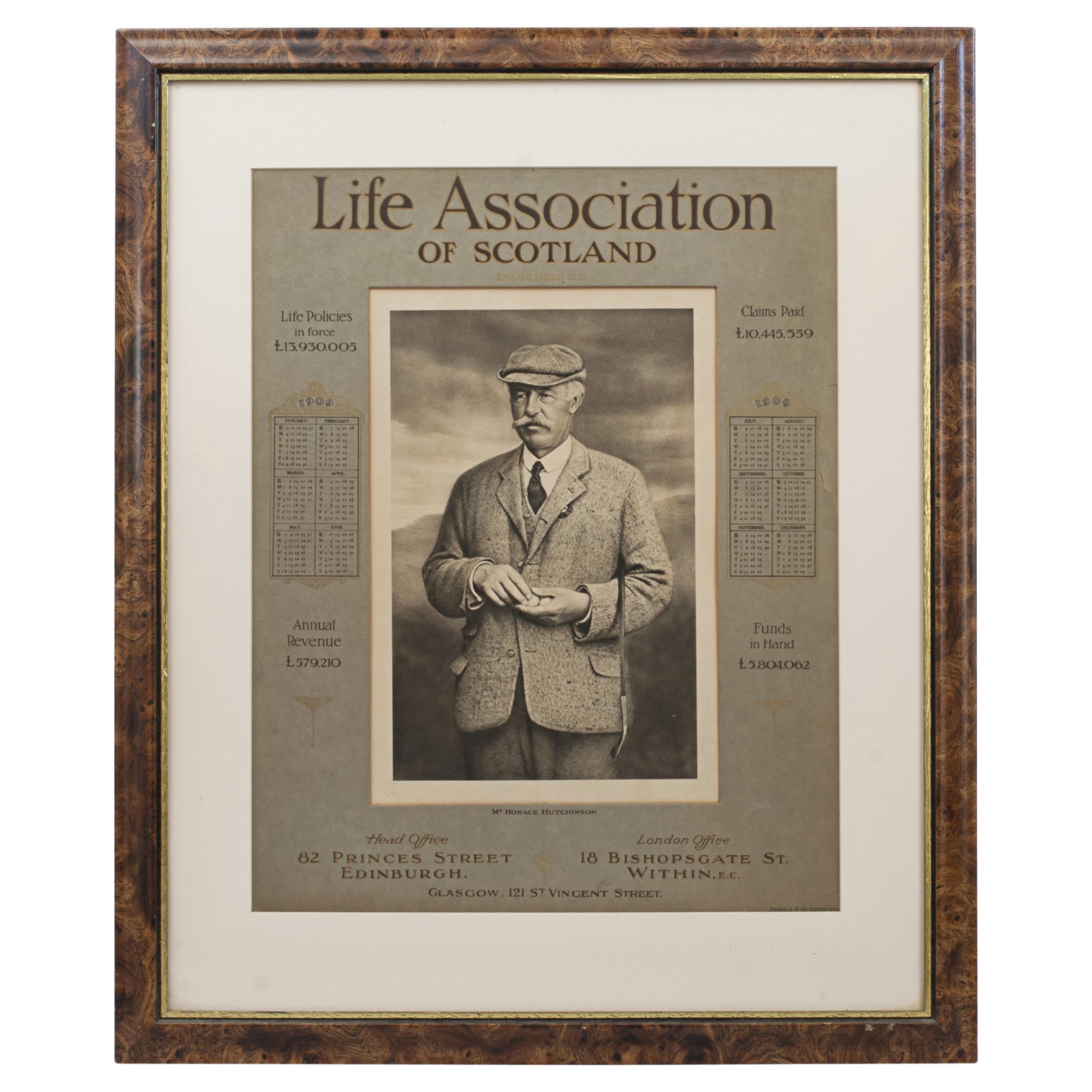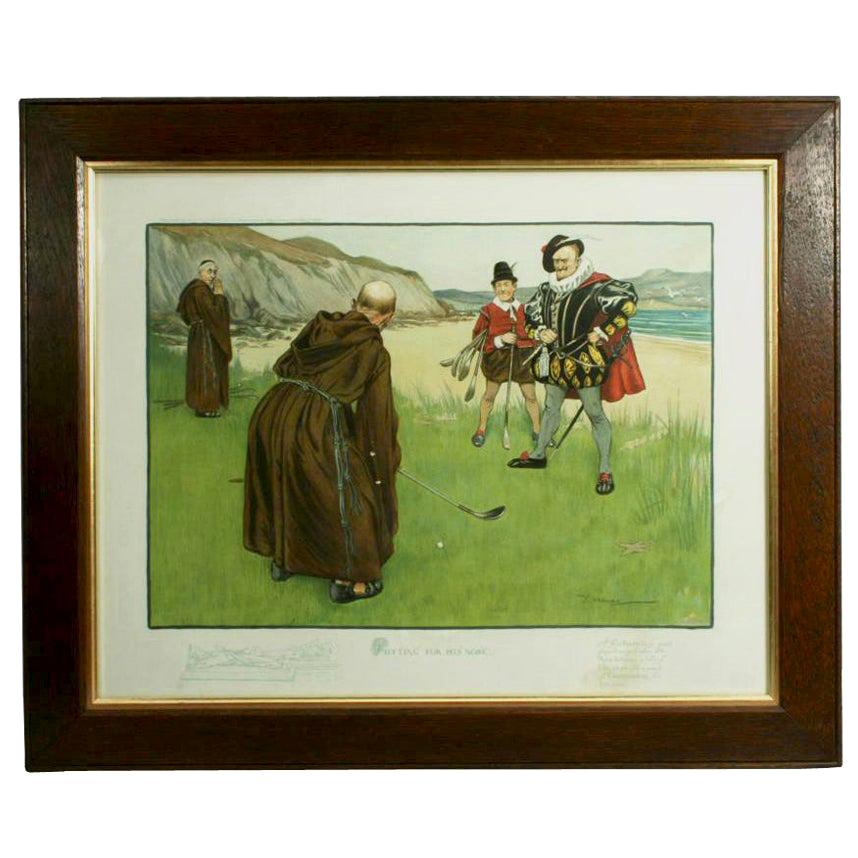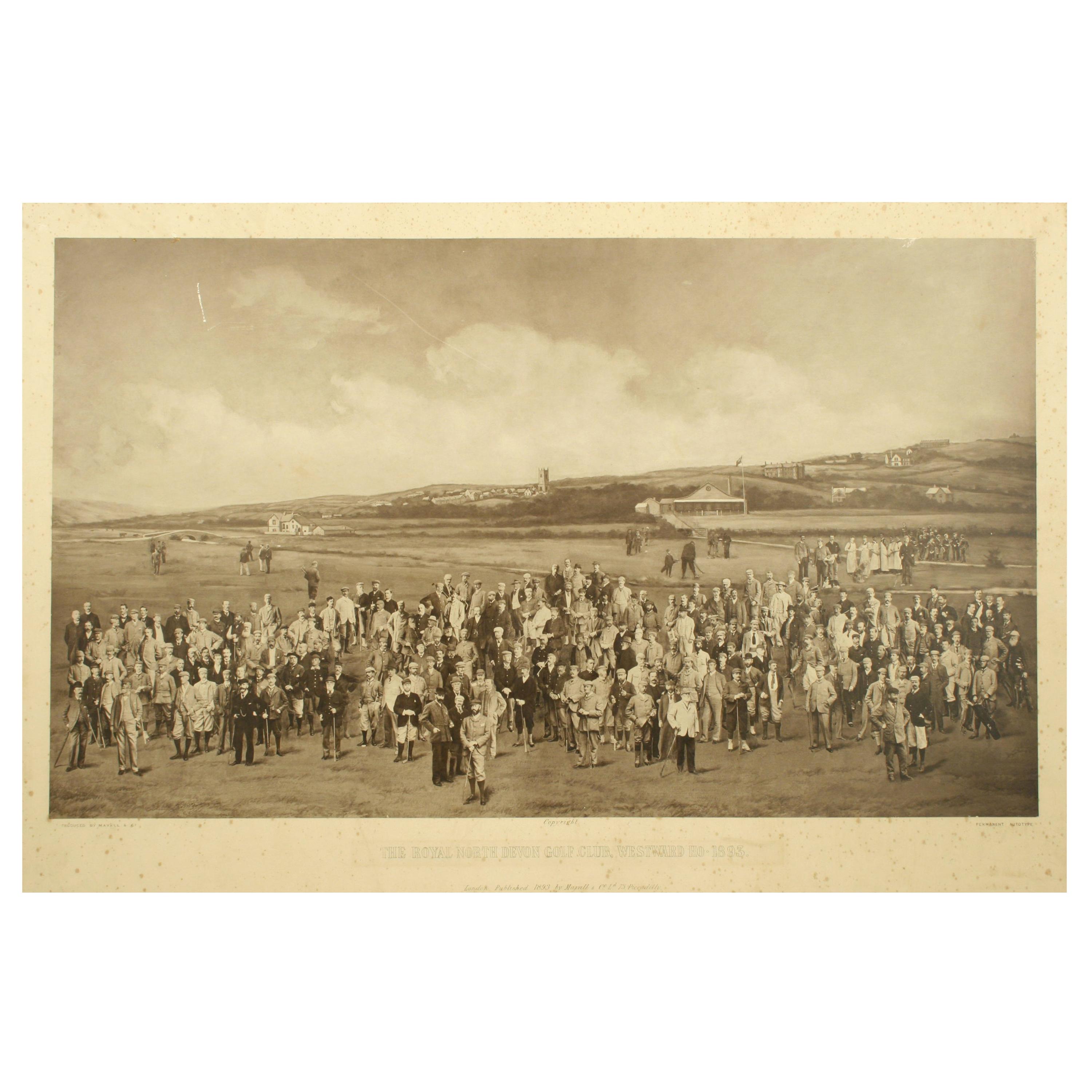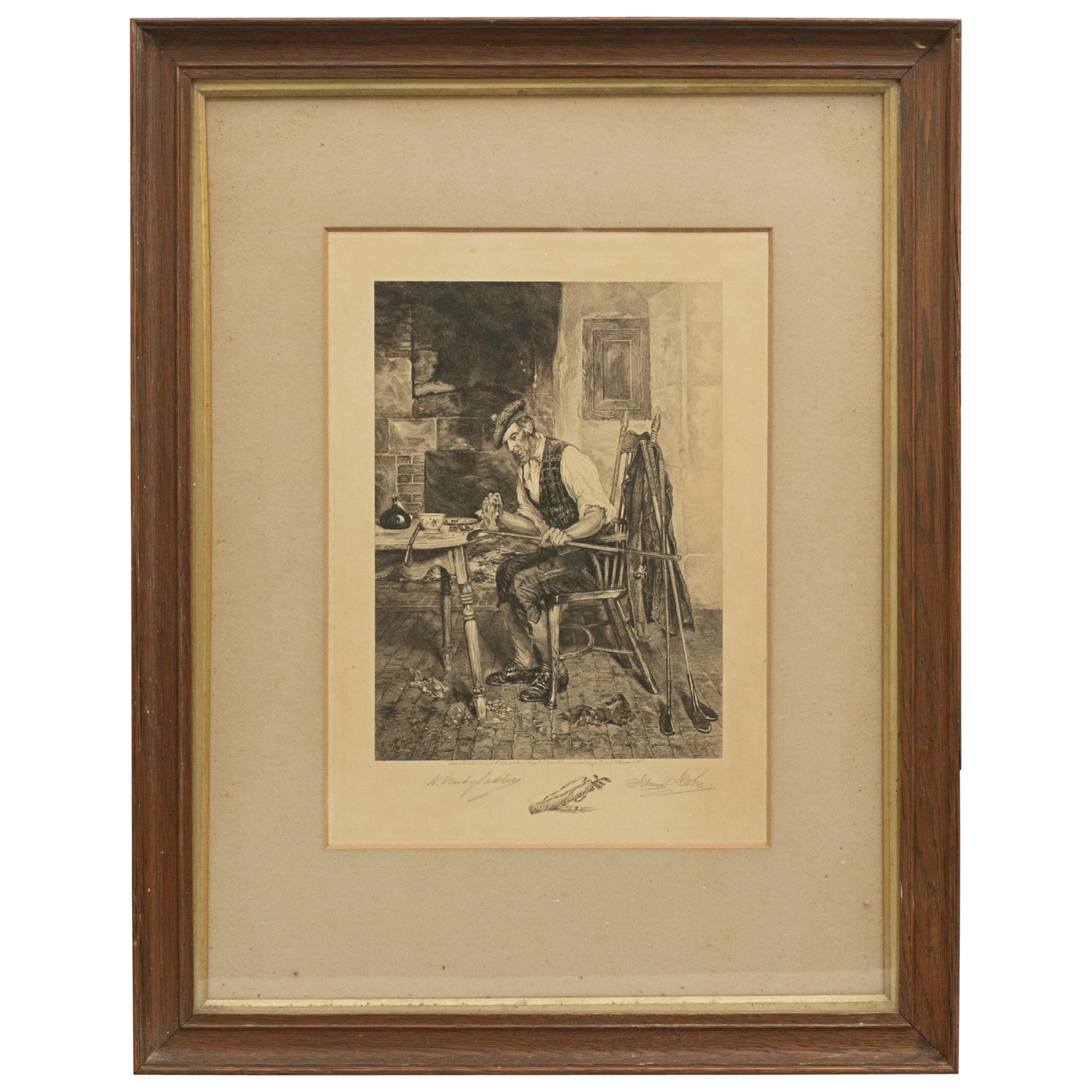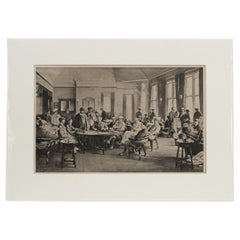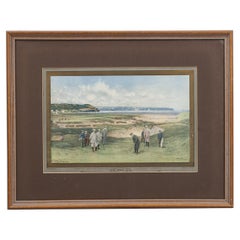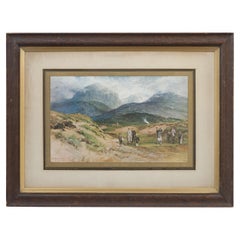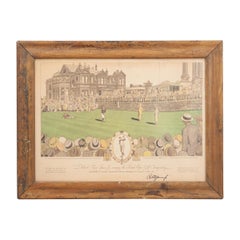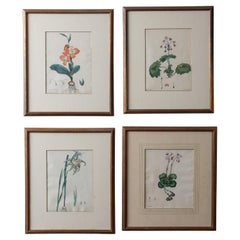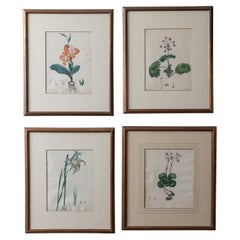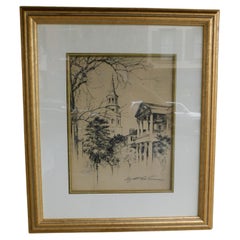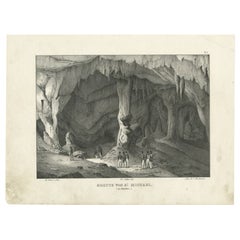Articles similaires à St Andrews, Life Association Print By Michael Brown Golf Print
Vous voulez plus d'images ou de vidéos ?
Demander au vendeur plus d'images ou de vidéos
1 sur 12
St Andrews, Life Association Print By Michael Brown Golf Print
À propos de cet article
Michael Brown Life Association Golf Photogravure, St. Andrews - High Hole.
A golf photogravure after Michael Brown: St. Andrews - High Hole. (Coming Home), from his famous series of scenes commissioned by the Life Association of Scotland for their calendars. This one featured on their 1912 calendar and has Mr. Guy Campbell, Mr. L.M. Balfour-Melville, Mr. J.L. Low and Mr. Edward Blackwell at the 11th hole (High Hole) St Andrews. Nicely framed in a period oak frame with a gold slip, mount window also with a gold slip.
Leslie Balfour-Melville (9 March 1854 - 17 July 1937), born Leslie Balfour, was a Scottish amateur sportsman, serving as captain, opening batsman, and wicket-keeper for the Scotland national cricket team. Balfour-Melville was also an international rugby union player, tennis player, ice skater, curler, long-jumper, and player of English billiards. He was a prolific golf medal winner, winning The Amateur Championship, at St Andrews in 1895. He also held several administrative positions within national governing bodies. He was President of the Scottish Rugby Union, President of the Scottish Cricket Union, and Captain of The Royal and Ancient Golf Club of St Andrews in 1906. (Wikipedia)
Edward Baird Hay Blackwell (21 July 1866 - 22 June 1945) was a Scottish amateur golfer who played in the late 19th and early 20th century. He was a member of The Royal and Ancient Golf Club of St Andrews and finished in second place in the 1904 Amateur Championship contested at Royal St George's Golf Club in Sandwich, England. Although playing fine golf throughout, he eventually lost the final match to Walter Travis by the score of 4 and 3. He was known as a long hitter of the ball, often outdriving opponents by 50 yards or more. In 1898, Blackwell was described as probably the most consistently long driver the world had ever seen. As a result, his name became a household word among golfers. (Wikipedia)
The Life Association of Scotland was established in 1838 in Edinburgh. In the late 1800's golf courses were being established all over Scotland and the financial community set up the Insurance & Banking Golf Club on the Duddingston estate in 1895, beneath the spectacular backdrop of the extinct volcano, Arthur's Seat. To mark the opening of the extended Club House, Michael Brown was commissioned to paint a scene from an exhibition golf match at the Club. The 1899 Life Association of Scotland calendar used this image as its center piece. It was such a marketing success Brown was then commissioned to annually paint a golfing picture until 1916, prints were made of these originals and glued to the cardboard calendar that the Life Association of Scotland produced. Brown's original paintings adorned the walls of the Edinburgh head office for many years.
St Andrews "The Home of Golf" is on the Fife Coast of eastern Scotland and is considered the oldest and most iconic golf course in the world. The Old Course is 6721 yards with a par of 72. It is famous for the 'Swilcan Bridge' spanning the first and 18th holes and 'Hell Bunker'. Everyone who plays the 18th hole walks over the 700-year-old bridge, with it featuring in many iconic pictures of St Andrews. The Old Course remains a public golf course, open to all and apart from the clubhouse for the Royal and Ancient, there are clubhouses overlooking the links for The St Andrews Golf Club (1843) and The New Golf Club St Andrews (1902) for men and the St Rule Club (1896) and St Regulus Ladies Golf Club (1913) for women.
The Old Course was pivotal to the development of golf and how the game is played today. By 1754, St Andrews consisted of twelve holes, ten of which were played twice, making a round of twenty-two holes in all. The members deciding that the first four and last four holes on the course were too short combined them into four holes (two in and two out). St Andrews then became the first 18-hole golf course in the world, and a blue print for the modern course.
In 1863 the R&A appointed 'Old' Tom Morris as Custodian of the Links and with the skills he had learnt at his time in Prestwick, he went about rejuvenating St Andrews. He established separate tee boxes on each hole, the fairways were widened, the greens enlarged and two new ones were constructed. The hazards were actively managed (before then hazards and bunkers had been left to mother nature) all of this spread out play over larger areas, thus increasing the volume of golf being played at St Andrews. Tom introduced the concept of top-dressing greens with sand, was the first to use a push mower to cut greens and all the time this was helping to improve the quality of the course. He also owned a shop and workshop at 8 The Links, which still exists.
Dimensions:
Height
23.5 cm / 9 1⁄2"
Width
37 cm / 14 "
Framed height
51.5 cm / 20 1⁄2"
Framed width
65 cm / 25 3⁄4"
Framed depth
2 cm / 1"
- Dimensions:Hauteur : 51,5 cm (20,28 po)Largeur : 65 cm (25,6 po)Profondeur : 2 cm (0,79 po)
- Style:Sporting Art (De la période)
- Matériaux et techniques:
- Lieu d'origine:
- Période:
- Date de fabrication:1912
- État:Usure conforme à l'âge et à l'utilisation. Photogravure in good condition, frame with the odd scuff mark.
- Adresse du vendeur:Oxfordshire, GB
- Numéro de référence:Vendeur : 305821stDibs : LU975745240752
À propos du vendeur
5,0
Vendeur Platine
Vendeurs premium dont la note est supérieure à 4,7 et le délai de réponse de 24 heures maximum
Établi en 1977
Vendeur 1stDibs depuis 2013
779 ventes sur 1stDibs
Temps de réponse habituel : 2 heures
Associations
LAPADA - The Association of Arts & Antiques Dealers
- ExpéditionRecherche du devis...Expédition depuis : Oxfordshire, Royaume-Uni
- Politique des retours
Certaines parties de cette page ont été traduites automatiquement. 1stDibs ne garantit pas l'exactitude des traductions. L'anglais est la langue par défaut de ce site web.
Garantie d'authenticité
Bien qu'il soit peu probable que la situation se présente, dans le cas où vous rencontreriez un problème d'authenticité d'un article, contactez-nous dans un délai d'un an pour obtenir un remboursement intégral. DétailsGarantie de remboursement
Si votre article n'est pas conforme à la description, est endommagé pendant le transport ou ne vous est pas livré, contactez-nous sous 7 jours pour obtenir un remboursement intégral. DétailsAnnulation sous 24 heures
Vous disposez d'un délai de 24 heures pour annuler votre achat sans motif.Des vendeurs professionnels agréés
Nos vendeurs de renommée mondiale doivent respecter des normes strictes en matière de service et de qualité, afin de préserver l'intégrité de nos fiches produit.Garantie d'alignement des prix
Si vous constatez qu'un autre vendeur a mis en vente le même article à un prix inférieur sur un autre site, nous nous alignerons sur ce prix.Livraison en toute confiance à l'international
Notre réseau de transporteurs de premier ordre propose des options d'expédition spécialisées dans le monde entier, y compris des livraisons personnalisées.Plus d'articles de ce vendeur
Tout afficherEstampe de golf, « Past Champions », Hoylake. Impression Life Association de Michael Brown.
Michael Brown Life Association Golf Photogravure, Surviving Amateur Champions.
Photogravure de golf d'après Michael Brown : Surviving Amateur Champions at Hoylake, de sa célèbre séri...
Catégorie
Antiquités, Début des années 1900, Britannique, Sporting Art, Estampes
Matériaux
Papier
Impression de golf ancienne Westward Ho!, Life Association of Scotland, Michael Brown
Vers l'ouest ! (Royal North Devon Golf Club) Approche du 4ème trou.
Calendrier de 1913 de la Life Association of Scotland, encadré et monté. Le calendrier est orné d'une magnifique p...
Catégorie
Début du 20ème siècle, Britannique, Sporting Art, Estampes
Matériaux
Papier
875 $US
Livraison gratuite
Royal County Downs Golf Course Print, Michael Brown, Life Association of Scotland
Terrain de golf Royal County Down.
Calendrier de 1914 de la Life Association of Scotland, encadré et monté. Le calendrier est orné d'une magnifique image colorée du Royal County Down Golf Course...
Catégorie
Vintage, Années 1910, Britannique, Sporting Art, Équipement et souvenirs...
Matériaux
Papier
Impression de golf de St Andrews signée Bobby Jones
Rare photo du championnat de golf Open 1927 signée par Bobby Jones.
Lithographie originale de 1930 à tirage limité intitulée "Robert Tyre Jones Jr. Gagner le championnat de golf Brit...
Catégorie
Vintage, années 1920, Américain, Sporting Art, Équipement et souvenirs s...
Matériaux
Papier
Calendar 1909, M. Horace Hutchinson
Gravure ancienne de golf de l'association Life, M. Horace Hutchinson.
Calendrier original de 1909 de la Life Association of Scotland. Le calendrier a été encadré et comporte une magn...
Catégorie
Début du 20ème siècle, Britannique, Sporting Art, Estampes
Matériaux
Papier, Bois
1 206 $US
Art de golf vintage humoristique, Putting for His Nose de Charles Crombie
Gravure de golf humoristique et colorée d'après Charles Crombie, intitulée "Putting for his Nose". Le tableau est encadré dans un vieux cadre en chêne marron foncé avec une feuille d...
Catégorie
Début du 20ème siècle, Britannique, Sporting Art, Estampes
Matériaux
Papier, Bois
Suggestions
Henry C. Andrews imprimés botaniques, vers les années 1790, lot de 4
Henry Cranke Andrews
(britannique, 1759-1835)
Un ensemble de quatre gravures botaniques colorées à la main publiées dans les années 1790.
14 ¾ par 17 ½ pouces
Catégorie
Antiquités, années 1790, Anglais, Estampes
Matériaux
Verre, Bois, Papier
1 200 $US / ensemble
Henry C. Andrews imprimés botaniques, vers les années 1790, lot de 4
Henry Cranke Andrews
(britannique, 1759-1835)
Un ensemble de quatre gravures botaniques colorées à la main publiées dans les années 1790.
14 ¾ par 17 ½ pouces
Catégorie
Antiquités, années 1790, Britannique, Estampes
Matériaux
Verre, Bois, Papier
1 200 $US / ensemble
Impression américaine de la réunion de l'église St. Michael's St. Charleston, SC Verner C 1930
Impression américaine de l'église St. Michael's sur Meeting Street, Charleston, SC. Mat sous verre dans un cadre doré. Elizabeth O'Neil Verner, début du 20e siècle.
Catégorie
Vintage, années 1930, Américain, Moderne, Estampes
Matériaux
Verre, Bois doré, Papier
Impression ancienne de la grotte de Saint-Michel à Gibraltar par Brodtmann, vers 1836
Gravure ancienne intitulée "Grotte von St. Michael". Gravure ancienne représentant une vue de la grotte de Saint-Michel à Gibraltar. Cette estampe provient de "Entdeckungs, Reise der...
Catégorie
Antiquités, XIXe siècle, Estampes
Matériaux
Papier
130 $US Prix de vente
20 % de remise
Deux gravures animées de personnages de dessins animés jouant au golf
Améliorez votre espace de vie avec ces captivantes impressions encadrées représentant des golfeurs de bande dessinée. Créés avec une attention méticuleuse aux détails, ces imprimés a...
Catégorie
Vintage, années 1920, Britannique, Victorien, Estampes
Matériaux
Verre
176 $US Prix de vente
60 % de remise
Impression de golf Art déco par Charles Lepas, France, années 1990
Par Charles Lepas
Le design Art Deco Golf Print de Charles Lepas, fabriqué dans les années 1990 en France, est une pièce remarquable qui allie l'élégance de l'Art Deco à l'attrait intemporel de l'imagerie du golf. Cette impression n'est pas seulement un objet de décoration mais une œuvre d'art sophistiquée qui apporte une touche de charme vintage et de raffinement culturel à n'importe quel espace.
Tout d'abord, le design de Charles Lepas est un hommage au style Art déco classique, caractérisé par ses motifs géométriques audacieux, ses couleurs riches et ses détails luxueux. Cet imprimé capture l'essence des années 1920 et 1930, évoquant un sentiment de nostalgie et de glamour. Le sujet, centré sur le golf, ajoute un élément unique et dynamique, ce qui en fait une pièce parfaite pour les passionnés de ce sport ainsi que pour les amateurs de beaux-arts.
La qualité de l'impression reflète le souci du détail et la maîtrise du design de Lepas. Les couleurs vives et les lignes précises témoignent d'un savoir-faire artisanal de haut niveau, ce qui garantit que l'œuvre d'art reste visuellement frappante au fil du temps. L'utilisation de matériaux de première qualité dans le processus d'impression garantit la durabilité et la longévité, faisant de cette pièce un investissement rentable.
Incorporer cette impression de golf Art...
Catégorie
Vintage, années 1920, Français, Art déco, Estampes
Matériaux
Bois, Papier
559 $US Prix de vente
20 % de remise
